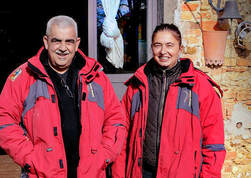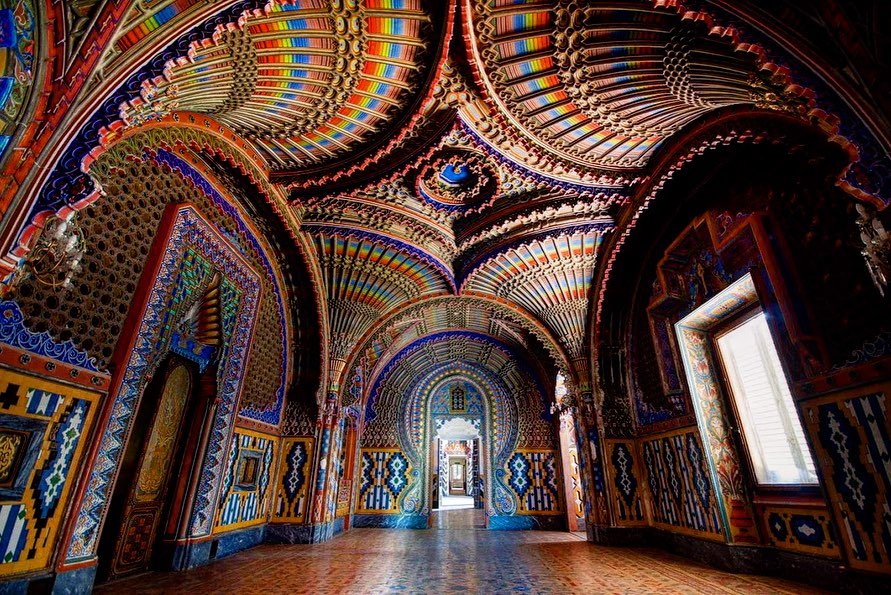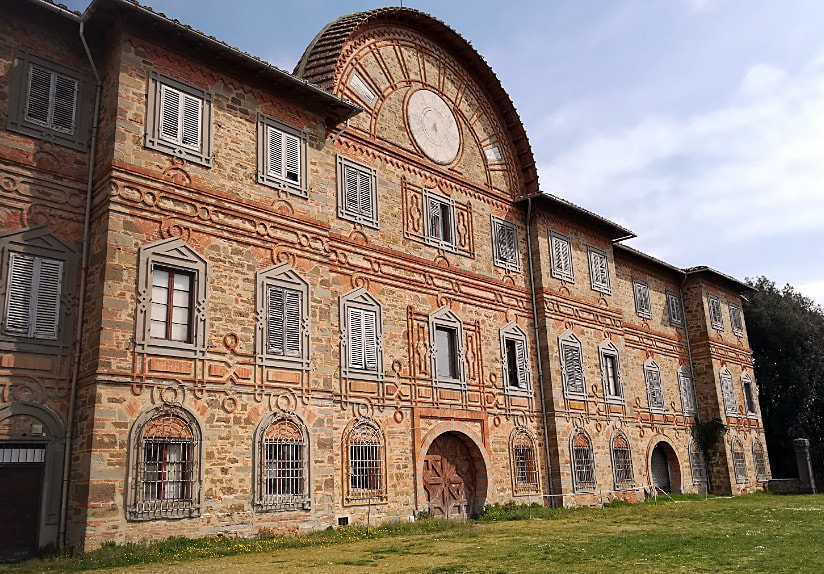 Stefano and Gianna Stefano and Gianna One of the highlights of our Voyage throughout Italy was our hot air ballooning adventure, flying over the Tuscan hillside with wisps of smoke filling the air from the burning of vine prunings down below. This flight was memorable not only for the beautiful scenery, but for the pilot that took us up into the Italian skies... Stefano Travaglia. Sadly, this Mago dell'Aria, a master pilot of ballooning, took his last flight this week on September 14th from his Barberino Taverelle home in Tuscany. As a mutual friend tells it, his wife Gianna said he had planned to work in his garden that morning, but she returned to discover that her dear Stefano had passed away gently in his sleep. Many knew Stefano. The people of his rural part of the Tuscan and Chianti regions knew him as a neighbor and friend. Always conscious of not disturbing his neighbors' fields or crops when landing, Stefano was quick to offer a bottle of Prosecco to farmers when he landed in their fields. He rarely imparted any damage to these fields, being such a masterful pilot, typically landing his balloon exactly where he wanted it, while not harming crops or other property. (I can attest to this... he landed our balloon after pointing out the landing spot from over a thousand feet above, reminding me of a major league baseball player pointing to the path of his home run). Thousands upon thousands around the world also knew him as "their" balloon pilot as he helped them discover a peaceful, childlike joy, flying them above vineyards, olive groves, villas or even the medieval towers of San Gimignano. Because he wanted to afford as many people as possible to fly silently through the air, he was the first balloonist in Italy to have a handicapped accessible basket.  Stefano with one of his pups Stefano with one of his pups Those in the aeronautic and ballooning world knew him for his skills as a pilot. After doing a stint in Manhattan as a commercial photographer, he returned to Italy and began a career with airplanes, but his interests soon turned to lighter than air flight after training with world renowned British balloonists. Today, there are many Italian hot air balloon pilots offering flights throughout Italy who Stefano personally trained. In fact, he and Gianna founded the Association Aerostatics Tuscany. Stefano was inspired by the first balloon flights of Montgolfier brothers from France in 1783. In fact, the Italian word for hot air balloon is mongolfiera. Second only to France, Italy also became a country with colorful balloons floating over its magnificent landscape. One early Italian ballooning passenger recalled after his flight, "Rome looked like a field which had been seeded with white flakes of plaster, while the Tiber seemed to be a very fine thread”. Stefano witnessed similar reactions to his many adventurers. Fly your highest in your last flight, Maestro del Cielo. The flight this time must be wonderful.
Our family offers hugs and prayers to Gianna, family and friends. Stefano's memory lives on. Be certain of it. --Jerry, Lisa and Lucas Finzi For many years, you couldn't visit. Then you could. Then you couldn't. Then you could again, but only by making an appointment way in advance. There was a time this magical place was going to ruin, with no one looking over it--caring for it. Then there was a group of volunteers who tried their best to look after its beauty. Then the place was put up for sale and bought, with an uncertain future again... Will the public ever be able to share in this amazing piece of architecture? Of course, we're talking about Castello di Sammezzano, the Moorish Revival palazzo in Leccio, a 45 minute drive from Florence and not too far from the local Mall Firenze.  The foundations of Sammezzano date back to the Romans and in the middle ages it was a defensive fortress--its most famous visitor being Charlemagne. Later on, its owners included such noble families as the Gaultierotti, the Altoviti and even the Medici. Around 1600, it was bought by the Portuguese nobleman Sebastiano Ximenes of Aragon and remained in the family until 1816, when it passed into the Panciatichi family via the wife of the last Ximenes d’Aragona.  The Marquis The Marquis Two generations later, it became the property of the man who changed its destiny: the Marquis Ferdinando Panciatichi Ximenes d’Aragona. Between 1842 and 1890, Ferdinando completely reshaped a medieval castle into an Orientalist palace in line with the fashion of the time, particularly in Florence. The result is a stunning mix of the Moorish with the Byzantine, the Indian with the Chinese. Using entirely local craftsmen, he had all the bricks, tiles and friezes made under his supervision on site. It's almost inconceivable that this palazzo has 365 rooms--one for every day of the year--each with its own name and unique style and decor. The more famous rooms are the Peacock Room with colorful geometric design, the White Room with its Moroccan mosaic tiled floors, the Hall or Mirrors and the octagon Smoking Room. In the Great White Rotunda there is a glass dome surrounded by a balcony, and the shields that adorn the base of the dome bear inscriptions: Fortitudo, Elementia, Temperantia, Pax, Prudentia, Justitia, and Libertas. There is even a small chapel in the palazzo. It would seem that the Marquis used just about every type of architectural element to enhance his creation: hidden niches, corners, friezes, windows, columns, labyrinths, capitals, arches, vaults and domes. Above an archway are the words "Non Plus Ultra", in Latin meaning "no more beyond", a saying that is said to have been inscribed on the Pillars of Hercules (nowadays known as the Strait of Gibralter), in part as a warning to sailors not to travel beyond the edge of the known world. Some think that the Marquis meant to take his visitors beyond the beauty of the known world when they entered his home. But perhaps, the meaning of a Latin phrase should be thought of in the way the ancient Romans used it, in this case, the highest level that could be attained or the the highest degree of a quality. This is, after all, what becomes evident to any visitor to Sammezzano. The quality of al the details are absolutely astounding. The beauty of the palazzo was even enough to entice Umberto I, King of Italy into visiting Ximenes at Sammezzano in 1878.
After the Second World War Sammezzano became a luxury hotel with apartments, spa, golf and country club until it closed in 1990. In 1999 it was bought by a British investor in 1999, and some stabilization restoration work was done. It has since been abandoned and closed to the public. In April 2012 a local non-profit committee called FPXA 1813-2013 (an acronym for Ferdinand Panciatichi Ximenes d’Aragon) was formed to attempt to restore and preserve the palazzo. Then came the auctions... three of them to date. Movimento Save Sammezzano was a group dedicated to finding an owner who would restore and honor the castle. Appreciating the architecture and uniqueness, in 2018 a Dubai-based company placed an offer of $18.1 million on the third auction and is the current owner. Considering the recent purchase, it is unsure if the Comitato FPXA is going to continue tours. In case they are still arranging tours, contact [email protected] (or join the Facebook page Sammezzano – Comitato FPXA). The Committee typically would organize several visits each year, which sell out almost immediately. www.sammezzano.org. Otherwise, do as the locals do and hike the many trails and dirt roads that surround the castle. You will see many of the giant sequoias along the eastern slope of the castle. Just be respectful and don't try to enter the castle itself unless you have joined an authorized tour group. --Jerry Finzi Two of the trails leading to the Sammezzano |
Categories
All
Archives
May 2023
|
























 RSS Feed
RSS Feed
